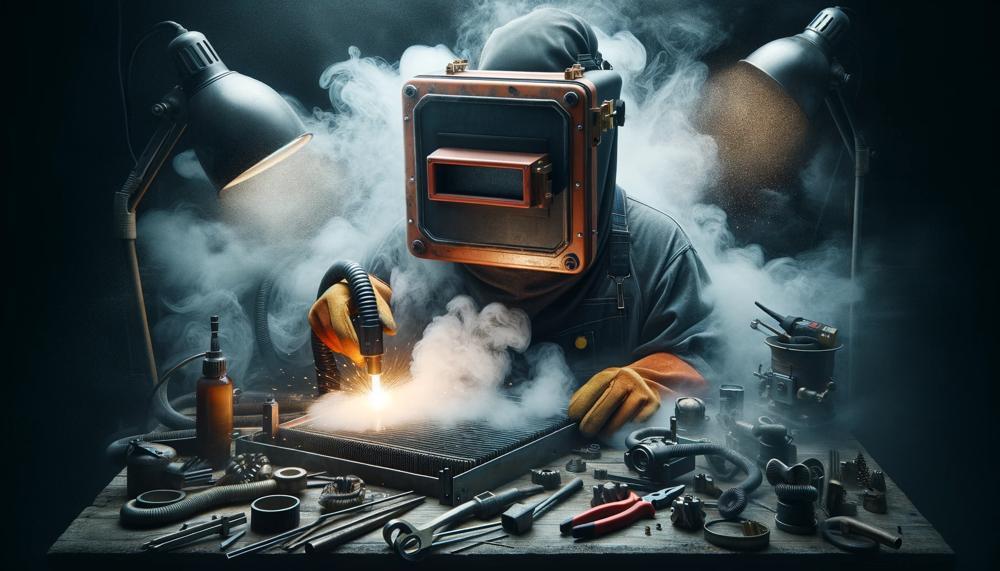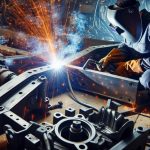Welding is a crucial process in various industries, from construction to manufacturing. However, this essential technique also comes with potential health hazards, particularly from the fumes produced during the welding process. These fumes contain a plethora of harmful substances that can cause respiratory issues and other health problems.
To protect welders and those working nearby, it is vital to have proper ventilation and filtration systems in place.
One type of filter commonly used for welding fumes is the high-efficiency particulate air (HEPA) filter. These filters are designed to capture tiny particles, including those found in welding fumes, with an impressive 99.97% efficiency rate. Let’s take a closer look at HEPA filters for welding fumes:
- Made up of densely packed fibers, HEPA filters effectively trap particles as small as 0.3 microns.
- They are highly effective at removing hazardous substances such as metal oxides, ozone, and nitrogen oxides from welding fumes.
- Regular maintenance and replacement are necessary for these filters to perform optimally.
- When correctly installed and maintained, HEPA filters significantly reduce the risk of respiratory illnesses caused by welding fumes.
In this blog post, we will delve deeper into the benefits and importance of using HEPA filters for welding fumes. So if you want to learn more about how these filters can help create a safer working environment for welders and their colleagues, keep reading.
Contents
- 1 What Type Of Filter Is Used For Welding Fumes?
- 2 The Importance of Proper Filtration for Welding Fumes
- 3 Types of Filters Used for Welding Fumes
- 4 Mechanical Filters: How They Work and Their Effectiveness
- 5 Electrostatic Precipitators: A Different Approach to Filtering Welding Fumes
- 6 Activated Carbon Filters: An Emerging Technology for Welding Fume Control
- 7 Combination Filters: Providing Comprehensive Protection Against Welding Fumes
- 8 Conclusion
What Type Of Filter Is Used For Welding Fumes?
The presence of welding fumes can have a detrimental impact on the respiratory system, causing both immediate irritation and long-term health problems.
To safeguard against these harmful fumes, specialized filters such as HEPA filters, gas and vapor filters, and combination filters are utilized.
| Filter Type | Function | Effectiveness |
| HEPA Filter | Captures particles of 0.3 microns or larger in size | Efficiency rate of at least 99.97% |
| Gas and Vapor Filter | Eliminates toxic gases and vapors from the air | Highly effective against targeted pollutants |
| Combination Filter | Utilizes multiple filtration methods for comprehensive protection | Highly effective against a wide range of particles and gases |
Inhaling welding fumes can result in immediate discomfort to the eyes, nose, and throat due to the high concentration of gases present. Prolonged exposure may lead to more severe respiratory issues, such as asthma, COPD, and even lung cancer. While mechanical filters like HEPA filters are commonly used to remove particles from the air, their effectiveness can vary depending on particle size and airflow rate.
Electrostatic precipitators employ an electric field to capture particles, making them highly efficient for small particles but less effective for larger ones. On the other hand, activated carbon filters have become increasingly popular for their ability to adsorb harmful gases and vapors. However, they require frequent replacement.
Combination filters offer a multi-stage approach by combining mechanical, HEPA, and chemical filtration methods. This makes them more effective than other types of filters as they target a wider range of particles and gases.
The Importance of Proper Filtration for Welding Fumes
Proper filtration is of utmost importance when it comes to safeguarding welders from the dangerous fumes and particles generated during welding. Inadequate filtration can lead to immediate discomfort and long-term health issues. Welding fumes contain hazardous substances like metal oxides, ozone, and volatile organic compounds (VOCs), which can pose serious health risks and create unsafe working conditions.
To ensure complete protection against welding fumes, a combination of filters is recommended. These combination filters use a multi-stage approach, including mechanical filtration, HEPA filtration, and chemical filtration, to target a wide range of particles and gases. This makes them ideal for high-risk environments where various fumes and particles may be present.
Mechanical filters, such as particulate filters, are the most commonly used type of filter for controlling welding fumes. They physically trap particles in the air as it passes through the filter. However, these filters may not be effective for smaller particles or when clogged, which can happen quickly in welding environments.
Electrostatic precipitators are another type of filter commonly used for controlling welding fumes. They use an electric field to capture charged particles in the air. While effective for smaller particles, larger ones may be more difficult to capture.
Activated carbon filters have gained popularity in recent years due to their ability to adsorb gases and vapors. However, they require frequent replacement as the activated carbon becomes saturated with the captured gases and vapors.
Types of Filters Used for Welding Fumes
There are multiple types of filters used for welding fumes, each with their own unique method of shielding against harmful particles. These include mechanical filters, electrostatic precipitators, activated carbon filters, and combination filters.
Mechanical Filters:
Mechanical filters are the most commonly used type of filter for welding fumes. They function by entrapping particles in a physical barrier, such as a mesh or fibrous material, as air passes through them.
The effectiveness of mechanical filters depends on the size of the particles and the airflow rate. They are most efficient at capturing larger particles, but may not be as effective for smaller particles.
Electrostatic Precipitators:
Electrostatic precipitators use an electric field to collect and eliminate particles from the air. As particles pass through the electric field, they become charged and are then attracted to oppositely charged plates or collection surfaces.
This makes electrostatic precipitators highly proficient at capturing small particles, but not as much for larger ones.
Activated Carbon Filters:
Activated carbon filters are gaining popularity for filtering welding fumes due to their ability to adsorb harmful gases and vapors.
These filters work by trapping gases and vapors in the microscopic pores of activated carbon, which has a vast surface area for maximum absorption. However, activated carbon filters need frequent replacement to maintain their effectiveness.
Combination Filters:
Combination filters combine multiple filtration methods for comprehensive protection against welding fumes. These filters typically use mechanical, HEPA (high-efficiency particulate air), and chemical filtration methods to target a wide range of particles and gases.
This multi-stage approach makes combination filters more effective than other types of filters.
Mechanical Filters: How They Work and Their Effectiveness
When it comes to protecting workers from the dangers of welding fumes, mechanical filters play a crucial role. By physically trapping particles, they prevent these harmful substances from entering the air and posing a threat to anyone in the vicinity. This makes them highly effective in removing pollutants and ensuring a safe and healthy working environment.
Moreover, mechanical filters are not just effective, but also easy to maintain. With their large surface area, they can capture a significant amount of particles before needing to be replaced. This not only reduces maintenance costs but also minimizes downtime for welding workshops, allowing workers to focus on the task at hand without worrying about filter maintenance.
However, it is important to note that even the most efficient mechanical filters require regular maintenance and replacement to continue functioning effectively. Neglecting this crucial aspect can lead to decreased efficiency and potentially expose workers to the hazardous effects of welding fumes. As such, proper maintenance and replacement schedules should be adhered to for optimal performance and worker safety.
Electrostatic Precipitators: A Different Approach to Filtering Welding Fumes
The use of electrostatic precipitators in welding processes has been gaining popularity due to their unique approach and numerous benefits. One such benefit is their higher efficiency, which is attributed to their ability to capture even the tiniest of particles that traditional filters may miss. This leads to cleaner air and a safer working environment for welders. In addition, electrostatic precipitators have lower operating costs as they do not require frequent filter replacements like traditional filters do.
Moreover, electrostatic precipitators have a longer lifespan as they do not physically trap particles, reducing the risk of clogging and wear and tear. This translates to significant cost savings in the long run. Additionally, these innovative devices have the added capability of removing harmful gases, providing a more complete solution for welding fume removal.

In contrast, traditional filters may only be able to capture particles but are unable to effectively remove gases. This can lead to the continued exposure of welders to toxic fumes, posing serious health risks. With electrostatic precipitators, not only are harmful particles removed from the air, but gases are also eliminated, ensuring a safer working environment for welders.
Activated Carbon Filters: An Emerging Technology for Welding Fume Control
Activated carbon filters are a cutting-edge technology for managing welding fumes, offering a multitude of advantages for both employees and companies. These advantages include:
- Enhanced air quality: Activated carbon filters efficiently remove hazardous fumes and particles from the air, elevating the overall air quality in the workplace and reducing potential health hazards for workers.
- Worker well-being: By eliminating harmful particles and gases from the air, activated carbon filters safeguard workers from potential health risks associated with welding fumes.
- Flexibility: These filters can be used for a variety of welding processes, making them a convenient option for businesses that utilize different welding techniques.
- Cost-efficient: Compared to alternative methods of managing welding fumes, activated carbon filters are a more cost-effective solution. They have a longer lifespan and require minimal maintenance, resulting in reduced costs for businesses.
- Easy to install and maintain: Activated carbon filters are straightforward to install and maintain, making them a hassle-free option for businesses. This also means they can be quickly replaced or repaired if needed.
- Customizable: These filters can be tailored to fit specific needs and environments. This allows businesses to personalize their fume control system to their unique requirements, ensuring maximum effectiveness.
- Durable: Activated carbon filters are known for their long-lasting durability and efficiency. They have a longer lifespan compared to other methods and can effectively remove fumes for extended periods.
- Environmentally conscious: Utilizing activated carbon filters can also benefit the environment as they do not produce any harmful byproducts or chemicals.
- Increased efficiency: With improved air quality and worker safety, businesses may also see an increase in productivity and efficiency as workers are not at risk of being exposed to harmful fumes.
Combination Filters: Providing Comprehensive Protection Against Welding Fumes
For welding professionals, protecting their health and well-being is a top priority. This is why combination filters are essential in promoting clean air and ensuring comprehensive protection against welding fumes.
Unlike other types of filters, combination filters utilize a multi-stage approach to filtration. The first stage involves a pre-filter that effectively traps larger particles like dust and debris, preventing clogging and extending the lifespan of the filter.
The next stage uses a HEPA (High-Efficiency Particulate Air) filter, which has an impressive 99.97% efficiency in capturing tiny particles. This includes hazardous welding fumes such as metal oxides, ozone, and other volatile organic compounds (VOCs).
Lastly, the final stage of a combination filter utilizes activated carbon or charcoal to neutralize gases and vapors produced during welding. These can include toxic gases like carbon monoxide, nitrogen oxides, and ozone, which can have serious health effects.
Conclusion
In summary, welding is a vital process in various industries, yet it poses potential health hazards due to the fumes produced. To safeguard workers and those in the vicinity, proper ventilation and filtration systems are necessary.
One commonly used filter for welding fumes is the high-efficiency particulate air (HEPA) filter, boasting an impressive 99.97% efficiency rate in capturing particles as small as 0.3 microns. However, there are also other options available such as gas and vapor filters, activated carbon filters, and combination filters.
Combination filters utilize a multi-stage approach to filtration, making them highly effective in removing a wide range of particles and gases from welding fumes. Not only are they easy to maintain and cost-efficient, but they are also customizable and environmentally friendly.
By improving air quality and ensuring worker safety, businesses may also see a boost in productivity and efficiency.





